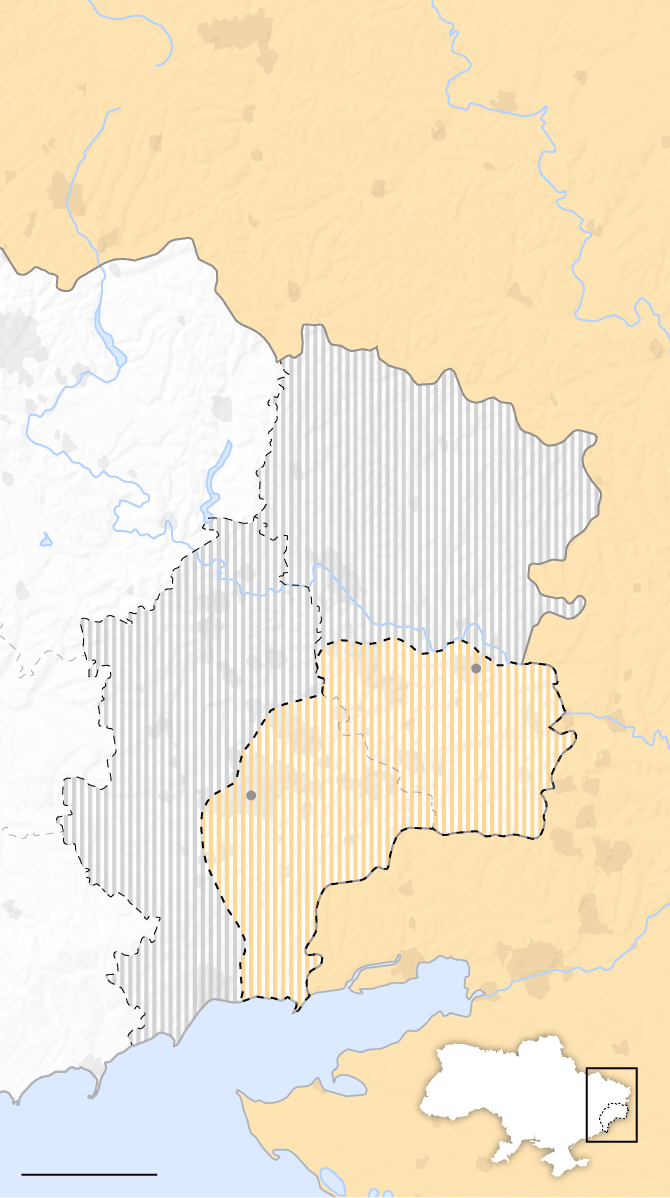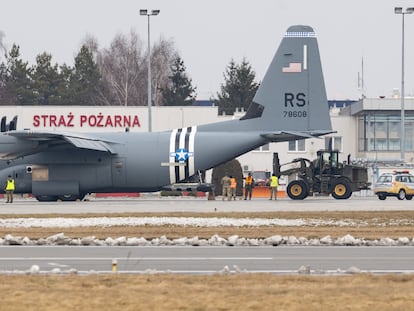The Russian attack in maps: Troops cross the Ukrainian border
Vladimir Putin announced the start of a ‘special military operation’ in the early hours of Thursday morning, which has already seen major explosions in various parts of the east of the former Soviet republic
The rising tensions in the east of Europe have just boiled over. The Russian president, Vladimir Putin, announced in the early hours of Thursday morning a “special military operation” in the Ukrainian region of Donbas. The objective, according to the leader, is to demilitarize the country, although the attack against the former Soviet republic is looking more and more like a major invasion. This is the story of the attacks via maps:
The Russian troops were this morning crossing the border in various points of Ukraine, according to confirmation from the country’s Interior Ministry. The attack began minutes after Putin made his announcement of action in Donbas.
The offensive, which began in Odessa and Crimea, saw major explosions in the regions of Sloviansk, Kramatorsk, Járkov and even Kyiv. There were also deflagrations in the separatist regions of Donetsk and Luhansk, whose independence was recognized by the Russian government on Monday.
According to the Ukrainian state emergency service, the Russian attacks have reached 10 regions in the east and south of the country. The Russian Defense Ministry has stated it is using “high-precision weapons” to cripple military infrastructure. The Ukrainian government decreed a state of emergency on Wednesday and closed the airports of Jarkov, Zaporiya and Dnipro.
February 22
Russia sends troops to the Ukrainian region of Donbas

Putin has ordered troops to be sent to Donbas after recognizing Luhansk and Donetsk as independent.
Belgorod
Soloti
Valuyki
RUSSIA
Kharkiv
LUHANSK
UKRAINE
Under
Ukrainian
control
DONBAS
Luhansk
Area under control
of pro-Russian
separatists
DONETSK
Donetsk
UKRAINE
Sea of Azov
100 km

Putin has ordered troops to be sent to Donbas after recognizing Luhansk and Donetsk as independent.
Belgorod
Soloti
Valuyki
RUSSIA
Kharkiv
LUHANSK
UKRAINE
Under
Ukrainian
control
DONBAS
Luhansk
Area under control
of pro-Russian
separatists
DONETSK
Donetsk
UKRAINE
Sea of Azov
100 km

Soloti
UKRAINE
Valuyki
Kharkiv
RUSSIA
LUHANSK
UKRAINE
Under
Ukrainian
control
DONBAS
Luhansk
Area under control
of pro-Russian
separatists
DONETSK
Donetsk
Putin has ordered troops to be sent to Donbas after recognizing Luhansk and Donetsk as independent.
Mariupol
Sea of Azov
100 km

Belgorod
Soloti
UKRAINE
Valuyki
Khariv
RUSSIA
LUHANSK
Under
Ukrainian
control
Millerovo
Luhansk
DONBAS
UKRAINE
DONETSK
Area under control
of pro-Russian
separatists
Putin has ordered troops to be sent to Donbas after recognizing Luhansk and Donetsk as independent.
Donetsk
Mariupol
Rostov-on-Don
100 km
Sea of Azov
The war in Ukraine has now lasted eight years. In March 2014, following a referendum that the international community deemed illegal, Russia annexed the Crimea peninsula and offered military and economic support for separatists in the Donbas region. A month later, the latter proclaimed independence from Ukraine, triggering a conflict that has dragged out for eight years and claimed over 14,000 lives.
The fighting has divided the Donbas region into two separate areas, one on each side of the frontline. The eastern zone, which borders Russia, is controlled by separatists who are backed by the Kremlin; the western zone remains under the control of Ukraine’s armed forces. Separatists are claiming the entire territories of Donetsk and Luhansk, although they only have control over a third of the land – around 6,500 square kilometers (2,500 square miles), according to the Organization for Security and Co-operation in Europe (OSCE).

Deployment of troops and battle groups in the Russian area of Soloti, close to the Donbas region. February 13.
Convoy of the motorized rifle regiment battalion to the northeast of the Soloti garrison. February 20.
New military unit located to the east of Valuyki, in Russia. February 20.
Small unit deployed next to a treeline in the northwest of Belgorod. February 20.
Satellite photos: Maxar Technologies © 2022.

Deployment of troops and battle groups in the Russian area of Soloti, close to the Donbas region. February 13.
Convoy of the motorized rifle regiment battalion to the northeast of the Soloti garrison. February 20.
New military unit located to the east of Valuyki, in Russia. February 20.
Small unit deployed next to a treeline in the northwest of Belgorod. February 20.
Satellite photos: Maxar Technologies © 2022.

Deployment of troops and battle groups in the Russian area of Soloti, close to the Donbas region
February 13
Convoy of the motorized rifle regiment battalion to the northeast of the Soloti garrison
February 20
New military unit located to the east of Valuyki, in Russia
February 20
Small unit deployed next to a treeline in the northwest of Belgorod
February 20
Satellite photos: Maxar Technologies © 2022.
February 20
Deployment of Russian troops near Ukraine

Moscow
RUSSIA
El 21 de febrero Putin reconoce la independencia de las provincias de Lugansk y Donetsk y ordena el envío de tropas a la región.
BELARUS
Kiev
UKRAINE
Donbas
Transnistria
MOLDOVA
ROMANIA
Crimea
Black Sea
250 km
Crimea was annexed by Russia in 2014. Donbas is a Ukrainian region in which separatists supported by Russia control a third of the territory.
Russian troops
Unknown
number
of troops
5,000
1,000
Updated: February 20

RUSSIA
Moscow
LITHUANIA
BELARUS
On February 21, Putin recognized the independence of the Luhansk and Donetsk provinces and ordered troops to be sent to the region
Kiev
UKRAINE
Donbas
Transnistria
MOLDOVA
ROMANIA
Crimea
Black Sea
250 km
Crimea was annexed by Russia in 2014. Donbas is a Ukrainian region in which separatists supported by Russia control a third of the territory.
Russian troops
Unknown
number
of troops
5,000
1,000
Updated: February 20

Moscow
Kaliningrad
RUSSIA
On February 21, Putin recognized the independence of the Luhansk and Donetsk provinces and ordered troops to be sent to the region
POLAND
Kiev
Donbas
Transnistria
MOLDOVA
Crimea
Krasnodar
ROMANIA
Black Sea
250 km
Crimea was annexed by Russia in 2014. Donbas is a Ukrainian region in which separatists supported by Russia control a third of the territory.
Unknown
number
of troops
Russian troops
5,000
1,000
Updated: February 20

5,000
Russian troops
Unknown
number
of troops
Updated:
February 20
1,000
LITHUANIA
Moscow
Minsk
POLAND
RUSSIA
BELARUS
Kraków
Voronezh
Chernobyl
Kiev
Russia has had a military presence in the Moldovan separatist region of Transnistria since the 1990s
UKRAINE
Luhansk
SLOV.
Donbas
On February 21, Putin recognized the independence of the Luhansk and Donetsk provinces and ordered troops to be sent to the region
Volgograd
Donetsk
Transnistria
HUNGARY
MOLDOVA
Sea of Azov
Crimea
ROMANIA
Krasnodar
Black Sea
250 km
Crimea was annexed by Russia in 2014. Donbas is a Ukrainian region in which separatists supported by Russia control a third of the territory.
In November, Russia began to amass troops and weapons along its border with Ukraine. The defense consulting firm Rochan Consulting, which has been monitoring the deployment, on January 27 calculated that over 100,000 Russian soldiers were already positioned near the border. The latest moves by Russia and the beginning of what Rochan is calling “a new phase,” in which units are no longer just congregating at meeting points but operating in more dispersed areas, will make it complicated to monitor movement on the ground. According to “Western sources” cited by the BBC news organization, two-thirds of Russian forces are now less than 50 kilometers (31 miles) from the border with Ukrainian territory. Besides the soldiers deployed near Ukraine, Moscow also has 30,000 soldiers, heavy equipment as well as airplanes and combat helicopters in Belarus.
The US Ambassador to OSCE, Michael R. Carpenter, on Friday figured that between the Russian troops near the Ukrainian border as well as those in Crimea and Belarus, Moscow might have between 169,000 and 190,000 soldiers in and around Ukraine. To this must be added the approximately 2,000 troops that, according to the Polish think tank Warsaw Institute, Moscow has in Transnistria, an unrecognized breakaway state with a Russian-speaking population that declared independence from Moldova in 1990.
January 29
Invasion options

BELARUS
RUSIA
Belgorod
Kiev
Total
Río Dnieper
UKRAINE
Donbas
Vinnytsia
Dnipro
Odessa
MOLD.
ROMANIA
East
South
250 km
Crimea
Black Sea

BELARUS
RUSSIA
Belgorod
Kiev
Total
Dnieper River
UKRAINE
Donbas
Vinnytsia
Dnipro
Odessa
MOLD.
ROMANIA
East
South
250 km
Crimea
Black Sea

BELARUS
Troebortnoe
Mazyr
RUSSIA
POLAND
Chernobyl
Belgorod
Kiev
Total
Dnieper River
Lviv
UKRAINE
Vinnytsia
Donbas
SLOV.
Dnipro
Luhansk
Donetsk
HUNGARY
MOLD.
Melitopol
Odessa
East
ROMANIA
South
250 km
Crimea
Black Sea

BELARUS
Troebortnoe
Mazyr
RUSSIA
POLAND
Korosten
Chernobyl
Belgorod
East option
Kiev
Lviv
Dnieper River
Total option
UKRAINE
Vinnytsia
Uzhorod
Donbas
Kremenchuk
SLOV.
Dnipro
Luhansk
Donetsk
HUNGARY
MOLDOVA
South option
Melitopol
Odessa
Kherson
Rostov-on-Don
ROMANIA
250 km
Crimea
Black Sea
Analysts feel that the most likely scenarios for an alleged Russian invasion of Ukraine are the following:
1. South option. Russian troops would try to secure Ukrainian territory located along the Black Sea. This strip would extend from the Donbas region to Transnistria, in Moldova, and include the Crimea peninsula, illegally annexed by Russia in 2014. This possibility would ensure water supply to Crimea after Kyiv cut it off eight years ago, and it would also leave Ukraine landlocked.
2. East option. Russian soldiers could penetrate separatist areas of the Donbas region, without advancing any further into Ukraine, or else try to gain control over all the Ukrainian territory east of the Dnieper, a river that splits the country in half. This military advance would involve taking Kyiv, possibly with help from Russian troops stationed in Belarus, whose border is 80 kilometers (50 miles) from the capital.
3. Total option. A full-scale invasion of Ukraine is the least likely scenario because of the difficulty of controlling a territory of over 600,000 square kilometers (233,062 square miles) and a population of 44 million according to the World Bank. Popular opposition could end up being a more determining factor than a purely military resistance by the Ukrainian armed forces, who are vastly outnumbered by the Russian army. Besides the huge differences in terms of weapons, Ukraine only has 209,000 troops on active duty compared with 900,000 in the Russian army, according to the Stockholm International Peace Reserch Institute (SIPRI).

